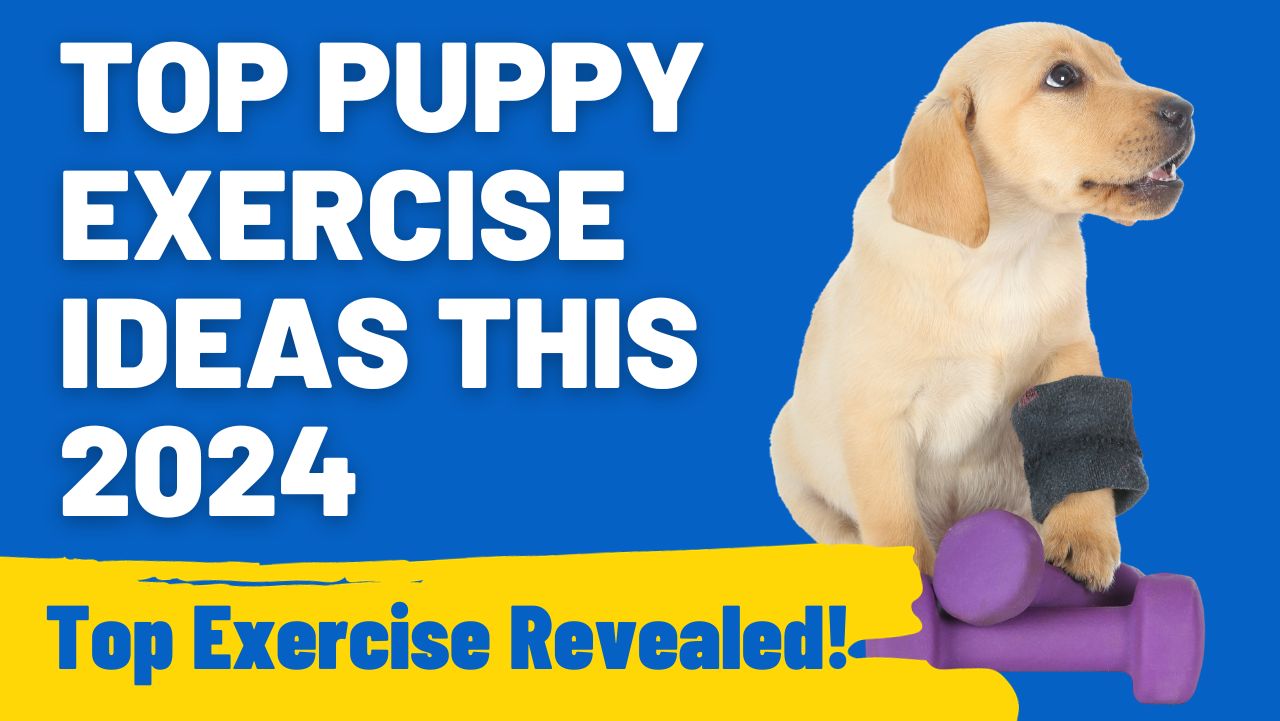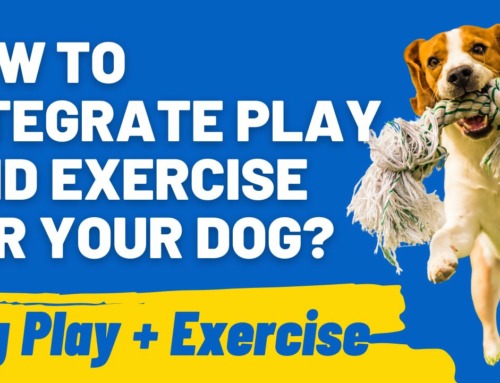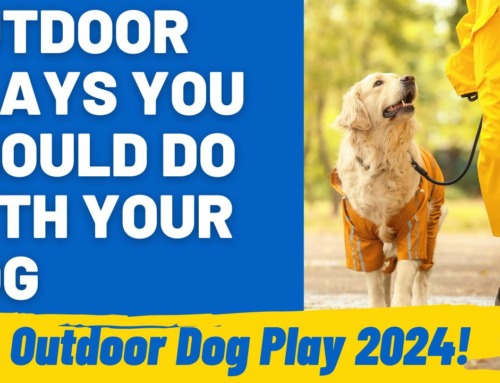Are you on the hunt for puppy exercise ideas to keep your furry friend happy and healthy?
You’re not alone! Many pet parents realize that exercise is much more than just a way to burn energy; it’s a crucial component of a puppy’s overall development.
From mental stimulation to physical health, the right activities can make a world of difference in your puppy’s life. Let’s explore some fun and healthy exercises that will benefit your four-legged family member!
Why Is Exercise Vital for Your Puppy’s Development?

Puppies are bundles of joy, filled with endless energy and curiosity. But, just like children, they need a proper outlet for that energy. Exercise is not just a physical activity for puppies; it’s a critical aspect of their overall development.
Firstly, exercise plays a significant role in managing a puppy’s energy levels. A well-exercised puppy is often a well-behaved puppy.
Without adequate physical activity, puppies can turn to destructive behaviors as a way to release their pent-up energy.
Chewing, digging, and excessive barking are often signs of under-exercise. By incorporating regular exercise into your puppy’s routine, you can avoid these common behavioral issues.
Besides energy management, exercise is fundamental to a puppy’s physical health. It aids in building strong muscles and bones, which is particularly important during their rapid growth phase.
Exercise also helps maintain a healthy weight, preventing obesity, which can lead to various health issues later in life, including joint problems and diabetes.
Mental stimulation is another crucial benefit of exercise. Engaging your puppy in different forms of physical activity helps to keep their minds active and sharp.
This mental engagement is just as important as physical activity, especially for intelligent and high-energy breeds.
Activities that challenge your puppy mentally, like learning new tricks or navigating an obstacle course, can be incredibly satisfying and enriching for them.
Moreover, exercise can be a key factor in social development for puppies. Interactions during walks or playtime with other dogs can teach valuable social skills such as communication, boundaries, and proper play behavior.
These interactions are vital for developing a well-rounded, sociable, and confident adult dog.
The importance of exercise in a puppy’s life cannot be overstated. It’s a balancing act between managing energy, ensuring physical health, providing mental stimulation, and encouraging social development.
What Are the Best Puppy Exercise Ideas?
So, what’s the secret to a happy and healthy puppy? The answer lies in a variety of creative and fun exercise ideas! From classic games to innovative activities, there’s no shortage of ways to get your puppy moving and grooving.
Whether you’re indoors or out in the great wide open, there are plenty of options to suit every puppy’s needs and preferences.
Indoor Exercise: What Can You Do Inside?
Rainy days or limited outdoor space? No problem! There are plenty of engaging indoor activities to keep your puppy active and entertained. Here are some great ideas:
- Hide and Seek: Enhance your puppy’s problem-solving skills by playing hide and seek. Hide behind furniture or in different rooms and call your puppy to find you. It’s a great way to stimulate their mind and body!
- Obstacle Course: Create a simple indoor obstacle course using household items like cushions, boxes, and towels. Guide your puppy through the course, encouraging them to climb, jump, and maneuver around obstacles.
- Tug-of-War: A sturdy rope or a tug toy can provide hours of fun. Tug-of-war is not just a physical exercise; it also helps in teaching your puppy important lessons about bite inhibition and control.
- Interactive Toys: There are numerous interactive toys available that can keep your puppy occupied. Puzzle toys that dispense treats as a reward for solving them are great for mental stimulation.
- Teach New Tricks: Indoor time is perfect for teaching your puppy new tricks. Sit, stay, roll over – every new trick is a mental workout for your puppy and strengthens your bond.
- Balancing Games: Challenge your puppy’s balance and coordination with simple balancing games. Have them walk on a cushioned beam or balance on an unstable surface like a pillow.
Remember, indoor activities are not only about physical exercise; they’re also about keeping your puppy’s mind sharp and engaged. Mix and match these ideas to create a fun indoor routine for your puppy!
Outdoor Adventures: What Are Safe and Fun Options?

When the sun is shining and the outdoors beckons, it’s the perfect opportunity for some puppy exercise! Safe and fun outdoor activities not only help in physical development but also offer a wealth of sensory experiences for your puppy. Here are some great options:
- Leash Walking: Walking remains one of the best exercises for dogs. Start with short walks on a leash, gradually increasing the duration as your puppy gets older.
- Fetch: A classic game of fetch in a secure, open space is great for exercise and training. Use a puppy-safe ball or frisbee to keep the fun going.
- Puppy Playdates: Organize playdates with other vaccinated puppies. This is excellent for socialization and learning appropriate play behavior.
- Water Play: If your puppy likes water, shallow paddling pools or supervised beach trips can be a delightful experience.
- Nature Trails: Walking on different terrains like grass, sand, or leaves provides sensory stimulation and keeps walks interesting.
- Supervised Exploration: Allow your puppy to explore a safe outdoor area, sniffing around and discovering new things under your watchful eye.
Always ensure the safety of the outdoor activities, keeping your puppy away from hazardous areas and ensuring they’re always within your sight.
Interactive Play: How Can You Be a Part of the Fun?
Engaging in interactive play with your puppy isn’t just about their exercise; it’s a golden opportunity to deepen your bond.
Picture yourself teaching new tricks during playtime, turning each session into a joyful learning experience. Imagine the fun of tug-of-war, where you and your puppy learn about strength and control together.
Or consider agility training in your backyard, guiding your enthusiastic pup through a homemade course.
Don’t forget toys like Houndgame’s Puppy Play Mat, which offers a playful mix of chew and rope toys plus a nose squeaker – it’s an interactive playground that brings you and your playful puppy even closer.
How Much Exercise Does Your Puppy Need?
Figuring out just the right amount of exercise for your puppy can feel like a balancing act. It’s important to remember that puppies, like little humans, have varying energy levels and needs depending on their age and breed.
Generally, a good rule of thumb is about five minutes of exercise per month of age, up to twice a day. So, for a four-month-old pup, that’s 20 minutes of playtime twice a day.
But remember, every puppy is unique! It’s crucial not to overdo it; too much exercise can be just as harmful as too little.
Puppy Exercise Safety: What Should You Keep in Mind?
When it comes to exercising your puppy, safety is key! Here are some essential tips to ensure your pup’s playtime is not only fun but also safe:
- Start Slow: Especially with young puppies, it’s important to start slow and gradually increase the intensity and duration of exercises.
- Watch for Overexertion: Keep an eye out for signs of exhaustion, like heavy panting, slowing down, or lying down. Puppies often don’t know their limits, so it’s up to you to monitor their fatigue levels.
- Safe Environments: Choose safe, enclosed spaces for exercise, away from traffic and other hazards.
- Temperature Matters: Avoid exercising in extreme temperatures. On hot days, exercise during cooler mornings or evenings, and always provide plenty of water.
- Check the Surfaces: Exercise on soft, grassy areas to protect your puppy’s joints. Hard surfaces like concrete can be tough on their developing bodies.
- Post-exercise Check: After playtime, check your puppy for any signs of injury or discomfort. Pay special attention to their paws and pads.
- Consult a Vet: If in doubt, consult your vet for personalized advice, especially if your puppy has specific health considerations.
Enhancing Puppy Fitness: Can Other Activities Complement Exercise?
When we think about keeping our puppies fit, it’s not just about the physical hustle and bustle. Sure, a game of fetch or a brisk walk is fantastic, but there’s more to a well-rounded puppy workout.
Think about blending in some brain games and basic obedience training. These activities are like the mental yoga for your pup, keeping their minds as agile as their bodies.
Puzzle toys, hide-and-seek with treats, or simple commands like ‘sit’ and ‘stay’ can be incredibly beneficial.
This combination ensures your puppy is not just physically fit but also sharp, responsive, and mentally stimulated!
Age-Appropriate Exercise Ideas for Puppies
Below is a breakdown of exercise ideas tailored to your puppy’s age. This guide will help you choose activities that are both enjoyable and suitable for their development stage.
| Age | Exercise Ideas |
| 8-10 Weeks Old | Short walks (5-10 minutes) inside the houseGentle play with soft toysBasic obedience training (sit, come)Socialization with humans and vaccinated dogs in controlled environments |
| 11-14 Weeks Old | Slightly longer walks (10-15 minutes)Introduction to different terrains (grass, sand)Continued socializationSimple fetch with a soft ball |
| 4-6 Months Old | Regular walks (15-20 minutes)Introduction to water play (if comfortable)Basic agility training with low-impact obstaclesInteractive games like hide and seek |
| 6-9 Weeks Old | Longer walks (20-30 minutes)More advanced training commandsPlaydates with other dogsIntroduction to more challenging toys and puzzles |
| 9-12 Months Old | Regular walks (25-35 minutes)Continued obedience and agility trainingAdvanced puzzle toysStructured play and exercise routines |
Success Stories: How Has Exercise Benefited Puppies?
Hearing from pet parents themselves brings to life the wonders of a well-planned exercise regimen. Here are a couple of anecdotes that highlight just how transformative exercise can be for puppies:
“When we first got Benny, our energetic Labrador, he was a whirlwind of chaos! But once we started regular play sessions and walks, I noticed a huge change. He became more attentive, less destructive at home, and overall, a happier pup. The transformation was incredible!” – Julia, Benny’s owner
“Luna, our little beagle, was quite shy and reserved. Incorporating daily exercise routines, especially agility training, really brought her out of her shell. She’s not only physically fit but also much more confident and sociable now. Exercise was key to unlocking her vibrant personality.” – Amelia, Luna’s owner
These stories underscore the power of exercise in shaping a puppy’s life.
For Benny, structured physical activities were instrumental in channeling his energy positively, improving his behavior significantly.
In Luna’s case, exercise was not just about physical health; it played a critical role in her social and emotional development, enhancing her confidence and social skills.
Such examples highlight that exercise for puppies is more than just a physical necessity; it’s a cornerstone of their overall well-being, impacting their mental, emotional, and social growth.
Do Different Breeds of Puppies Need Different Exercise?

Ever wondered if different puppy breeds have different exercise needs? The answer is a resounding yes! Just like people, different breeds come with their own set of characteristics and exercise requirements:
- High-Energy Breeds: Think Border Collies, Australian Shepherds, and Labrador Retrievers. These breeds are like the athletes of the dog world and need more intense exercise. They thrive on activities like long walks, hikes, and fetch games.
- Low-Energy Breeds: Breeds such as Bulldogs, Basset Hounds, and Shih Tzus have a more laid-back approach to life. Shorter, less strenuous walks and play sessions suit them just fine.
- Small vs. Large Breeds: Small breeds often have bursts of energy and may enjoy quick, playful activities, whereas large breeds may prefer longer, steady exercises.
The key is to tailor the exercise to your puppy’s breed, size, and energy level. A Chihuahua won’t usually need the same level of activity as a Golden Retriever!
It’s all about finding that sweet spot that keeps your puppy healthy and happy, without overdoing it.
Tailoring Exercise to Your Puppy: How to Customize Activities?
Getting your puppy’s exercise routine just right can be a bit like mixing the perfect cocktail – it needs the right ingredients in the right proportions. It’s all about customizing activities to suit your puppy’s breed, size, and energy levels.
First up, consider your puppy’s breed. Different breeds have different exercise needs. For instance, a playful Jack Russell Terrier might need more mental stimulation during exercise, while a Great Dane might prefer a leisurely stroll.
Size matters too. Smaller breeds can be more susceptible to injuries from too much high-impact activity, so keep their play sessions short and sweet. On the other hand, larger breeds might require longer periods of exercise to burn off their energy.
And let’s not forget about your puppy’s unique personality and energy levels. Some puppies are natural-born sprinters who love a good game of fetch, while others might prefer a calm walk around the block.
The trick is to watch and learn from your puppy. Notice when they seem happiest and most engaged during exercise, and adjust accordingly.
It’s a process of trial and error, but once you hit that sweet spot, you’ll have a happy, healthy, and well-exercised pup on your hands.
Conclusion
Remember, exercising with your puppy isn’t just about keeping them physically fit; it’s about creating lasting memories, bonding, and experiencing the sheer joy of watching them grow into happy, healthy dogs.
From indoor puzzles to outdoor adventures, each activity brings its own set of benefits and smiles.
As you embark on this journey of playful discovery with your furry friend, don’t forget to check out HoundGames for an array of toys and resources tailored just for your dog’s needs.
Here’s to the countless happy moments and wagging tails that await you and your puppy!




